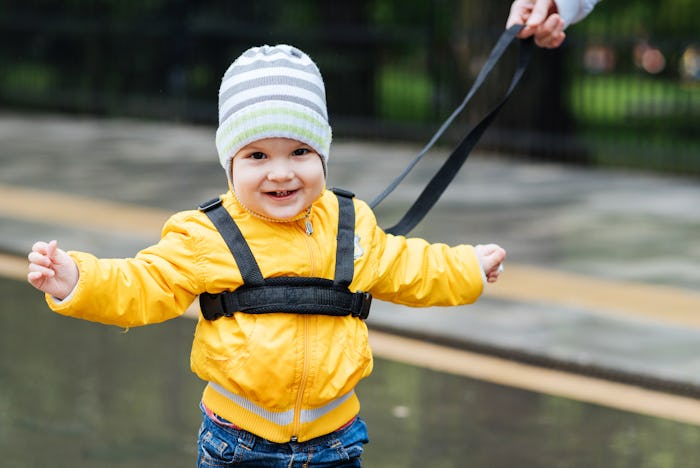You’ve seen them at the mall, on city streets, or walks in the park: Leashes for kids, a parent's last defense against busy toddlers who like to sprint away at a moment’s notice. Sometimes called toddler safety leashes, depending on the brand, they’re essentially a squishy, brightly colored form of baby handcuff. But are leashes for children safe to use?
“As a child therapy expert, my sense is they don't cause any real psychological harm and that our strong reactions to them are more about cultural norms than about any actual or lasting effects on the child's psychology,” therapist Brooke Sprowl, LCSW, tells Romper. “Of the scarce research that has been conducted, none suggests that child leashes do cause physical or psychological harm."
Of course, people tend to have a strong reaction to leashes in general because we're used to seeing dogs leashed, not children. “If it were culturally normative to leash children I don't think anyone would have such a strong reaction to them and I can't imagine children themselves expressing shame or humiliation about being leashed. If that were happening, we would know, and it would be a different story,” adds Sprowl.
For parents of children with special needs, multiple children, or children that run any time a parent looks away for a split second, Sprowl thinks child leashes are a good solution to keep them safe.
Shelli Dry, a pediatric therapist, tends to believe the same, albeit with some caveats.
“The first area to consider would be the purpose of the tether. Is it required for safety in an impulsive child or a child with special needs? When safety is a concern, it should take priority, however there are guidelines that should be followed,” Dry explains.
The child's age also needs to be taken into consideration. “The use of a tether can be effective in maintaining safety in a younger child, but other methods may need to be considered in the elementary age group,” she says.
Janice Robinson-Celeste, an early childhood specialist, daycare owner, and parenting author, agrees.
“As an early childhood specialist and a parent, I've used a 'leash' for one out of three of my own children because she was the one that could not be contained in one area,” Robinson-Celeste tells Romper. “It is a safety precaution and is often necessary. I would rather her be on a safety harness than run into open traffic or off of a pier into the ocean. Many times these restraints help children who are perfecting walking to prevent terrible falls and head injuries. There were many times that I lifted my child mid-fall with these straps as if she was a marionette and prevented her from hitting her head on the pavement.”
How you use the leash is important to keep in mind. Dry explains that parents should never pull or tug. “That could lead to injury and harm to the child,” she says. “The danger with wrist tethers are that the child could pull away sharply and injure their shoulder or arm. Safer alternatives to the wrist tether would be the harness backpacks or a walking handle in which the child learns to hold a loop or plastic handle.”
That’s where Robinson-Celeste sees opportunity with the tether concept. “These harnesses come in cute styles such as backpacks, butterfly wings, and other character shapes that make it fun for children to wear,” she says. “Young children have no idea that others look at these harnesses negatively and the children who wear these harnesses grow up to be just fine. Even preschools use safety ropes when they have groups of young children walking in public places.”
Another factor to consider is the necessity of a leash. “If the parent experiences a lot of anxiety and it interferes with them taking their children outdoors or on other events, but the tether increases the parents' feelings of competence and allows the child to go places with their parents, than tethering could be beneficial,” says Dry.
Regardless of whether you use a leash for our own peace of mind or to keep your rambunctious little one from running away, it should always be used to educate a child.
“Using a tether with a younger child should be a communication tool and teaching method to help children learn to stay beside their parent or caregiver,” says Dry. “The parent should express the loving desire to keep their child close by at all times. When the child learns to walk alongside the parent, than the use of the tether can be faded. In other words, use of a tether when used short term and in a loving manner as a teaching tool and for safety in a young child should not have a negative effect on the child.”
That said, you might still get a side-eye from passersby. Robinson-Celeste knows this feeling. “The worst part of using these harnesses and wrist links are the stares that you get from other people who don't understand that they are a safety precaution,” she says.
But there’s not much you can do about that. As Dry tells Romper, “Unfortunately as humans we cannot control other people's reactions and those reactions could negatively impact a child. So the stigma from being stared at or having your parents criticized could play a larger role in traumatizing the child than the correct use of a tether.”
Experts:
Brooke Sprowl, LCSW, MyClinical director, therapist, and founder of LA Therapy
Janice Robinson-Celeste, early childhood specialist and former parent educator, daycare owner, published parenting author, owner of Ethnic Animations, and the publisher of Successful Black Parenting magazine
Shelli Dry, a pediatric therapist, and director of clinical operations at Enable My Child
